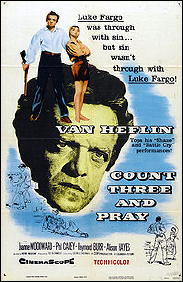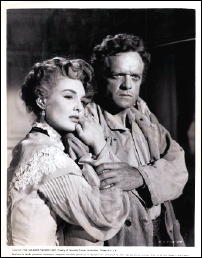Fri 18 Sep 2009
Movie Review: COUNT THREE AND PRAY (1955).
Posted by Steve under Reviews , Western movies[4] Comments
COUNT THREE AND PRAY. Columbia, 1955. Van Heflin, Joanne Woodward, Phil Carey, Raymond Burr, Allison Hayes, Myron Healey, Nancy Kulp, Jean Willes. Screenwriter: Herb Meadows. Director: George Sherman.

In all likelihood, this is Joanne Woodward’s least known motion picture. I may be wrong about that, but it is for a fact her first.
Before doing Count Three and Pray, she’d been on Broadway and she’d been on television, doing episodes of highly regarded series such as The United States Steel Hour, Alcoa Playhouse and Studio One.
It was on Broadway that she first met a fellow actor named Paul Newman; both were understudies for a run of “Picnic,” where they got along well, or so I’ve read.
I’ve categorized this movie as a western, but I’m not sure that it is, exactly, even though director George Sherman had directed tons of westerns, starting as far back as 1937. It does take place in the post-War South, that’s definite, but how far west Van Heflin’s rural home town is, the one he returns to, I’m not sure.
Van Heflin plays Luke Fargo, a veteran of the war and a man with a new goal in life. It seems that he fought for the North, a choice his former neighbors do not take kindly to when he returns. Before he left, he was also something of a hell-raiser. Now his only desire is to become the town’s preacher.
But the church has been destroyed, and the parsonage next door in bad shape and has been taken over and is lived in by a young orphan girl named Lissy (Miss Woodward), a true tomboy who wants nothing to do with Luke Fargo. As if she has any choice.

Running the town is a storekeeper named Yancey Huggins (Raymond Burr, in fine villainous form). Allison Hayes (later to become the “50 Foot Woman”) plays the daughter of one of the town’s former aristocrats, and you know how old Southern aristocrats fared after the War. Many of them had to make their lives over, in any way they could.
(It should be noted that the female star with Van Heflin in the still from the movie is Allison Hayes. It’s been difficult to find any contemporaneous publicity material which includes Joanne Woodward, which illustrates, I believe, how totally unknown she was to moviegoers at the time.)
As for Van Heflin, he plays weary and perhaps sorely misguided but determined very well, but Joanne Woodward is even better, as she brings an entirely unexpected light to his life – and to this movie as well.
Even this early in her career her Broadway training is very noticeable. She moves around the set with polished ease, makes it clear what she’s thinking without saying a word, and when she does speak she does so clearly and projects to the last seat in the balcony – and in the meantime, she is a ray of sunshine whenever she is on the screen. It is extremely clear that she would not be doing many more westerns in her movie-making career.
Two years later, she won an Oscar for Best Actress in a Leading Role for The Three Faces of Eve (1957).
September 18th, 2009 at 11:46 pm
I like this gentle movie, which has echoes of films like Friendly Persuasion and Stars in My Crown. Even Burr’s villain has a bit of a change of heart before it is over, and while Woodward is a revelation, Heflin brings a nice balance to his former hell raiser trying to reform himself and his neighbors. He was always the rare actor who could make simple goodness interesting.
As for setting I assumed this one was set in one of the border states like Kansas or Missouri since it didn’t seem to be the deep south, though there were towns that were pro South as far north as southern Pennsylvania, and certainly parts of Maryland were pro South. Even in the west there were areas where entire towns were Southern sympathizers. This one just looked as if it was supposed to be Eastern Kansas, Western Missourri or even parts of Arkansas.
Still this isn’t Woodward’s last western — she was great in the star studded western comedy/drama A Big Hand for the Little Lady.
You have to wonder if the studio knew quite what to do with her in this film. Watching it I couldn’t help but think back to Janet Leigh’s first big role in The Romance of Rosy Ridge, another tomboy post Civil War picture with Van Johnson all about healing the wounds left by the war.
As for George Sherman, he was still going strong for 1971’s John Wayne outing Big Jake, a solid western that sometimes gets lost amid the attention given True Grit, John Wayne and The Cowboys, and The Shootist as one of the Duke’s best later films.
September 19th, 2009 at 1:39 pm
Neither Kansas or Missouri feel exactly right to me, but I have to confess that I hadn’t seriously considered either one until you brought them up. Maybe they’ll grow on me, once I give them a chance.
Certain sections of Kentucky or Tennessee might be possibilities, but maybe the locale was supposed to be general and not specific.
September 19th, 2009 at 3:02 pm
A good deal of Eastern Missouri borders Tennesse. I thought of the border states only because it was fairly common to find unionists living in Southern enclaves there. But I’ll admit I didn’t think of Kentucky, and there were certainly Union sympathizers there, though in truth they were scattered throughout the South.
Even though my great great grandfahter was a Brigadier in the Texas Third Cavalry he had been a supporter of Sam Houston before the war trying to keep Texas out of the Confederacy and part of the Union, so the solid South was by no means solid before the war. Houston though a slave owner had been the key vote in the Senate keeping slavery out of the West.
September 22nd, 2009 at 6:22 am
This belongs to a definite sub-sub-genre I call Enjoyable Pacifist Westerns, which would include FROM HELL TO TEXAS and THE HANGING TREE.